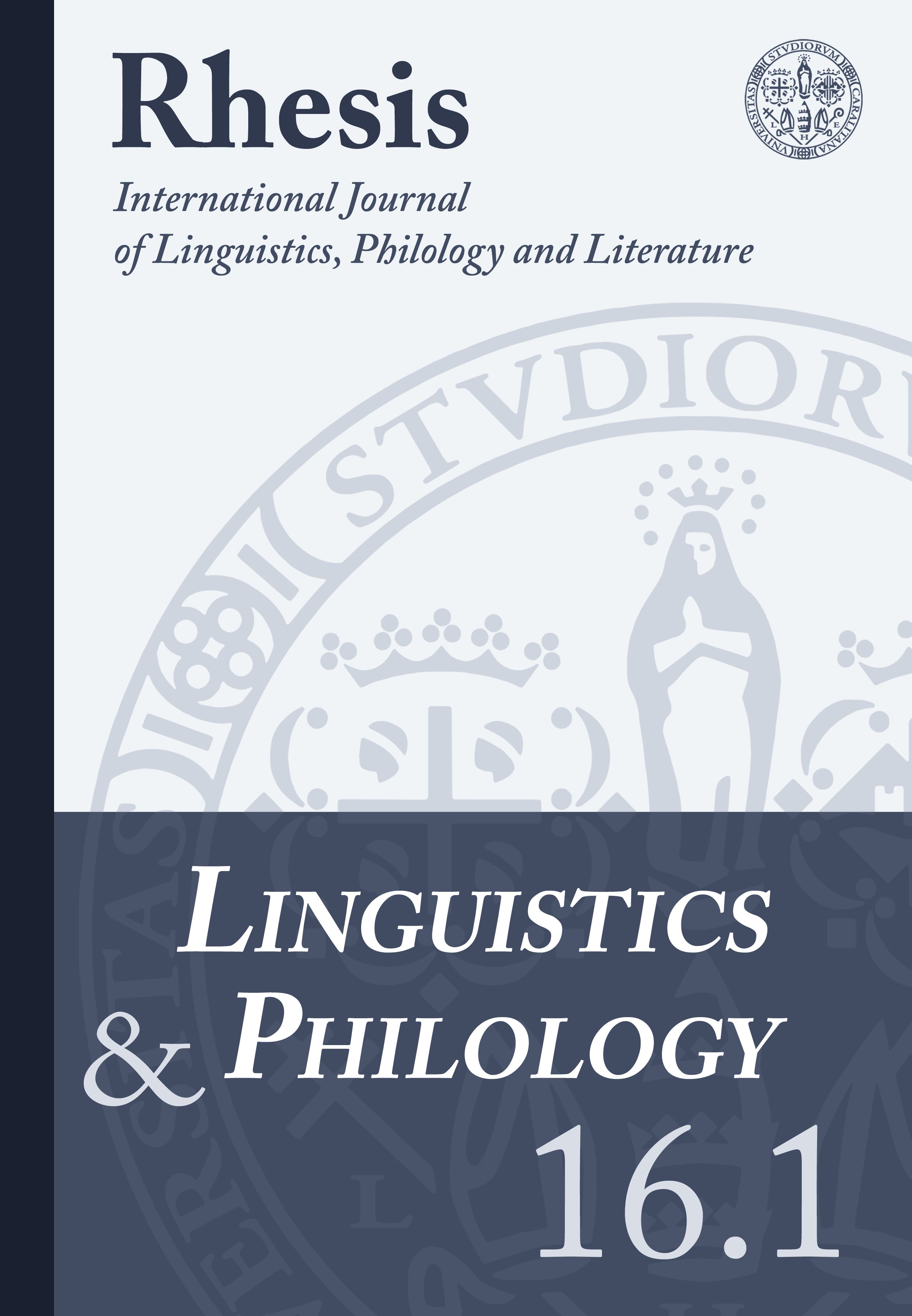Medieval Legal Manuscripts as Scanian linguistic evidence
Abstract
After almost four centuries of Swedish assimilation policies, the former Danish province of Scania is losing the grip on its linguistic peculiarities, defined as East Danish, in an almost total absence of tools for the study of this linguistic variety. Such absence is even more regrettable, as the Scanian language was the first language of Scandinavia to be standardised and recorded in legal texts such as the Law of Scania and the Church Law of Scania.
For the history of the Scanian language, younger manuscripts of these legal texts may give some information on how the language evolved (and preserved some peculiarities) up to the Swedish invasion, when a violent assimilation process was enforced. This result can be obtained examining the changes both in spelling and in wording that occurred to make the ancient text intelligible through time.
Downloads
References
Baker, Zachary James (2023), An Examination of the Scanian Experiment in ‘runica manuscripta’: An Orthographic and Paleographic Analysis of ‘Codex Runicus’ (AM 28 8vo) and ‘Mariaklage’ (SKB A 120), Oslo-Reykjavík, University of Oslo-University of Iceland, MA thesis.
Bately, Janet M. (1970), ‘King Alfred and the Old English Translation of Orosius’, Anglia 88, 433-460.
Bjerrum, Anders (1966), Grammatik over Skanske Lov: Efter B 74, København, Universitets Fond.
Brøndum-Nielsen, Johannes (ed.) (1933), Danmarks gamle Landskabslove med Kirkelovene, Band I. Skånske lov, Copenhagen, Det Danske Sprog- og Litteraturselskab-Gyldendal.
Faulkes, Anthony (ed.) (2005), Snorri Sturluson. Edda. Prologue and Gylfaginning, London, Viking Society for Northern Research.
Fenger, Ole (2002), Danmarkshistorie. 4: Kirker rejses alle vegne: 1050-1250, København, Gyldendal og Politiken.
Floræus, Jonas (1743), Flores Antiquitatis Scanicæ, Göteborg, Johann George Lange.
Hermanson, Lars (2000), Släkt, vänner och makt: En studie av elitens politiska kultur i 1100-talets Danmark, Göteborg, Historiska institutionen.
Holm, Johan (2005), ‘Nationalist Arguments as Instruments of War Propaganda in Sweden, 1655-80’, in Eriksonas, Linas; Müller, Leos (eds.), Statehood Before and Beyond Ethnicity: Minor States in Northern and Eastern Europe: 1600-2000, Bruxelles-Wien, Lang, 131-150.
Jespersen, Leon (2016), ‘The Military Imperative’, in Kouri, E. I.; Olesen, Jens E. (eds.), The Cambridge History of Scandinavia. Volume II. 1520-1870, Cambridge, Cambridge University Press, 310-325.
Jones, Gwyn (1968), A History of the Vikings, Oxford, Oxford University Press.
Jørgensen, Merete K. (1999), ‘Det danske sprog i den middelalderlige bog’, in Petersen, Erik (ed.) in samarbejde med Lotte Philipson og Anette Damm, Levende Ord & Lysende Billeder. Den middelalderlige bogkultur i Danmark, København, Mosegaard Museum-Det Kongelige Bibliotek, 185-192.
Katlev, Jan (2006), ‘Er der et sprog der hedder Skånsk?’, Mål og mæle 1, 121-132.
Larsson, Simon (2017), ‘Scientific historiography and its discontents: Danish and Swedish aristocratic empiricism’, in Haapala, Pertti; Jalava, Marja; Larsson, Simon (eds.), Making Nordic Historiography: Connections, Tensions and Methodology 1850-1970, New York, Berghahn, 129-151.
Lieberman, Felix (ed.) (1903-1916), Die Gesetze der Angelsachsen, I-III, Halle an der Saale, Niemeyer.
Linnæus, Carl (1751), Carl Linnæi Skånska resa, på höga öfwerhetens befallning förrättad år 1749, Stockholm, Lars Salvii.
Lundbladh, Carl-Erik (2012), Skånska dialektord, Uppsala, Institut för Språk och Folkminnen.
Möller, Peter, (1858), Ordbok öfver halländska landskaps-målet, Lund, Berling.
Mörner, Nils-Axel (1995), ‘Sea Level and Climate – the Decadal-to-Century Signals’, Journal of Coastal Research, Special Issue 17, 261-268.
Moseley, Christopher (ed.) (2010), UNESCO, Atlas of the World’s Languages in Danger, UNESCO, Endangered Languages, 12th ed., <https://unesdoc.unesco.org/ark:/48223/pf0000187026> (last accessed: 03/10/2024).
Mynors, R. A. B.; Thomson, R. M.; Winterbottom, Michael (eds.) (1998), William of Malmesbury: Gesta rerum Anglorum. The History of the English Kings I, Oxford, Clarendon Press.
Naismith, Rory (2017), Early Medieval Britain, c. 500-1000, Cambridge, Cambridge University Press.
Nilsson, Bertil (1998), Sveriges Kyrkohistoria. Band I: Missionstid og tidig Medeltid, Arlöv, Verbum.
Oakes, Leigh (2001), Language and National Identity: Comparing France and Sweden, Amsterdam, Benjamins.
Olrik, Jørgen; Ræder, Hans (eds.) (1931-1957), Saxonis Gesta Danorum, 2 vols., Copenhagen, Levin & Munksgaard.
Olsson, Nils Ludvig (1921), De fåste fjeden. Skånerim, Malmö, Framtiden.
ONP = Ordbog over det norrøne progsasprog, <https://onp.ku.dk/onp/onp.php> (last accessed: 03/12/2024).
Rapisarda, Stefano (2020), Filologi in guerra e in pace: Bédier, Auerbach, Curtius, Friedmann, Spitzer, Bloch, Soveria Mannelli, Rubbettino.
Rietz, Joan Ernst (1867), Svenskt Dialekt-Lexikon, Lund, Lundberg.
Ringgaard, Kristian (1986), ‘Fleksionssystemets forenkling og middelnedertysk’, Arkiv för nordisk filologi 101, 173-183.
Ringgaard, Kristian (1989), ‘Fleksionssystemets forenkling i dansk’, Arkiv för nordisk filologi 104, 160-165.
Sawyer, Birgit; Sawyer, Peter (2003), ‘Scandinavia enters Christian Europe’, in Helle, Knut (ed.), The Cambridge History of Scandinavia. Volume I. Prehistory to 1520, Cambridge, Cambridge University Press, 147-159.
Schmeidler, Bernhard (ed.) (1917), Adam von Bremen, Hamburgische Kirchengeschichte, Monumenta Germaniae Historica SS rer. Germ. 2, 3rd ed., Hannover-Leipzig, Hahn.
Skautrup, Peter (1944), Det danske Sprogs historie, København, Gyldendal.
Skovgaard-Petersen, Inge (2003a), ‘The Making of the Danish Kingdom’, in Helle, Knut (ed.), The Cambridge History of Scandinavia. Volume I. Prehistory to 1520, Cambridge, Cambridge University Press, 168-183.
Skovgaard-Petersen, Inge (2003b), ‘The Danish Kingdom: Consolidation and Disintegration’, in Helle, Knut (ed.), The Cambridge History of Scandinavia. Volume I. Prehistory to 1520, Cambridge, Cambridge University Press, 353-369.
Spurkland, Terje (2005), Norwegian Runes and Runic Inscriptions, Woodbridge, The Boydell Press.
Tamm, Ditlev (ed.) (2018), The Liber Legis Scaniae: The Latin Text with Introduction, Translation and Commentaries, London-New York, Routledge.
Tamm, Ditlev; Vogt, Helle (2016), The Danish Medieval Laws: The Laws of Scania, Zealand and Jutland, London-New York, Routledge.
Thurston, Tina (2002), Landscapes of Power, Landscapes of Conflict: State Formation in the South Scandinavian Iron Age, New York, Kluwer.
Townend, Matthew (ed.) (2012), ‘Sigvatr Þórðarson. Knútsdrápa’, in Whaley, Diana (ed.), Poetry from the Kings’ Sagas 1. From Mythical Times to c. 1035, Turnhout, Brepols, 649-663.
Vries, Jan de (1962²), Altnordisches Etymologisches Wörterbuch, Leiden, Brill.
Wulff, Frederik V.; Rahm, Lars A.; Larsson, Per (2001), A Systems Analysis of the Baltic Sea, Heidelberg, Springer.
Zilmer, Kristel (2006), ‘The Representation of Waterborne Traffic in Old Norse Narratives: The Case of the Baltic Sea Area’, Viking and Medieval Scandinavia 2, 239-274.



